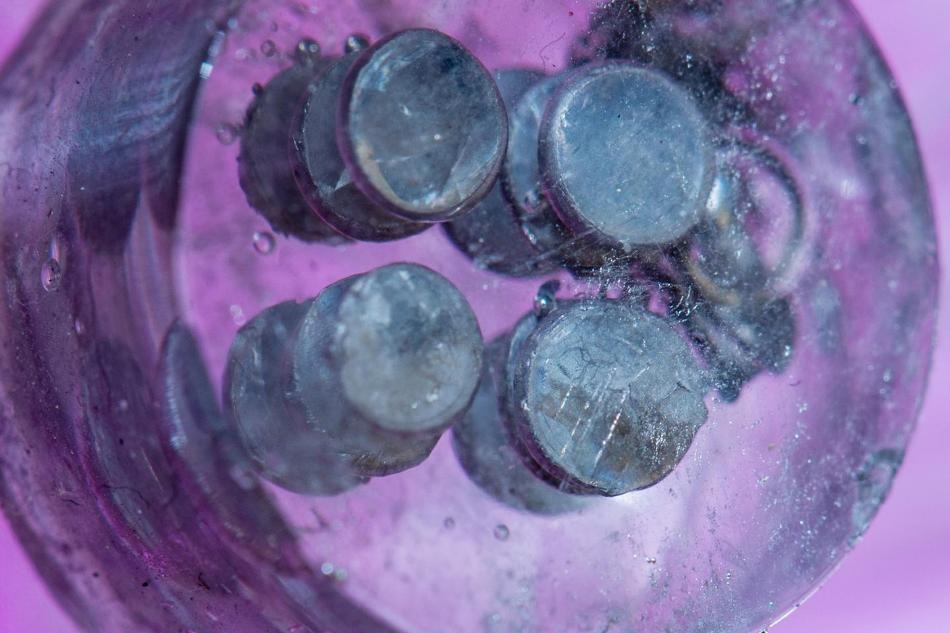Jul 11 2017
Materials Scientists at Rice University are drawing ideas from nature by studying, for instance, the discs in human spines and the skin in ocean-diving fish, to get clues about designing materials with apparently contradictory properties — stiffness and flexibility.
 Nature inspired the design of silicone and gallium composites created in Rice University’s the Nanomaterials Laboratory. (Photo by Jeff Fitlow/Rice University)
Nature inspired the design of silicone and gallium composites created in Rice University’s the Nanomaterials Laboratory. (Photo by Jeff Fitlow/Rice University)
In a research conducted by Graduate Student Peter Owuor, Research Scientist Chandra Sekhar Tiwary and colleagues from the laboratories of Rice Professor Pulickel Ajayan and Jun Lou, the team discovered they could increase the stiffness, or “elastic modulus,” of a soft silicon-based polymer by filling it with minute pockets of liquid gallium. Their research findings can be found online in the journal Advanced Materials Interfaces
Such composites could potentially be used in shock absorbers and high-energy absorption materials, and in biomimetic structures like artificial intervertebral discs, they explained.
Owuor said conventional wisdom in composite design spanning the last 60 years has been that incorporating a harder substance increases modulus and incorporating a softer one decreases modulus. In most cases, that is accurate.
People had not really looked at it from the other way around. Is it possible to add something soft inside something else that is also soft and get something that has a higher modulus? If you look at the natural world, there are plenty of examples where you find exactly that. As materials scientists, we wanted to study this, not from a biological perspective but rather from a mechanical one.
Peter Owuor, Graduate Student, Rice University
For instance, the discs between the vertebrae in human spines, which act like both ligaments and shock absorbers, are composed of a strong outer layer of cartilage and a soft, jelly-like interior. And the outer skin of deep-diving ocean fish and mammals contain countless minute oil-filled chambers — some no bigger than a virus and others bigger than complete cells — that allow the animals to endure the powerful pressures present thousands of feet under the ocean’s surface.
Selecting the basic materials to model these living systems was comparatively easy, but discovering a way to combine them to imitate nature proved problematic, said Tiwary, a Postdoctoral Research Associate in Rice’s Department of Materials Science and NanoEngineering.
Polydimethylsiloxane (PDMS) was selected as the soft encapsulating layer for several reasons. It is economical, nontoxic, inert and extensively used in numerous things spanning from caulk and aquarium sealants to food additives and cosmetics. It also dries clear, which enabled the team to easily see the bubbles of liquid they wanted to encapsulate. For that, the Researchers picked gallium, which like mercury is liquid at room temperature, but in contrast to mercury, it is nontoxic and easy to work with.
Owuor said it took almost four months to discover a recipe for encapsulating bubbles of gallium inside PDMS. His test samples measure approximately the diameter of a small coin and as much as a quarter of an inch in thickness. By curing the PDMS gradually, Owuor developed a process by which he could incorporate gallium droplets of many sizes. Some samples had one large inner chamber, and others had up to a dozen separate droplets.
Each sample underwent numerous tests. A dynamic mechanical analysis instrument was employed to measure how much the material deformed under load, and various measures like toughness, stiffness and elasticity were measured under a range of conditions. For instance, with a moderately small amount of cooling, gallium can be transformed into a solid. So the team was able to compare some measurements acquired when the gallium spheres were liquid with measures recorded when the spheres were solid.
Collaborators Roy Mahapatra and Shashishekarayya Hiremath of the Indian Institute of Science at Bangalore used finite element modeling and hydrodynamic simulations to assist the team in analyzing how the materials acted under mechanical stress. According to this, the Researchers established that pockets of liquid gallium gave the composite higher energy absorption and dissipation features than plain PDMS or PDMS with air-filled pockets.
What we’ve shown is that putting liquid inside a solid is not always going to make it softer, and thanks to our collaborators we are able to explain why this is the case. Next we hope to use this understanding to try to engineer materials to take advantage of these properties.
Chandra Sekhar Tiwary, Research Scientist, Rice University
Owuor and Tiwary said only using nanoengineering may not provide the greatest effect. Instead, nature makes use of hierarchical structures with features of differing sizes that repeat at larger scales, like those found in the oil-filled chambers in fish skin.
If you look at (the fish’s) membrane and you section it, there is a layer where you have spheres with big diameters, and as you move, the diameters keep decreasing. The chambers are seen across the whole scale, from the nano- all the way out to the microscale.
Peter Owuor, Graduate Student, Rice University
Tiwary said, “There are important nanoscale features in nature, but it’s not all nano. We may find that engineering at the nanoscale alone isn’t enough. We want to see if we can start designing in a hierarchical way.”
Ajayan is chair of Rice’s Department of Materials Science and NanoEngineering, the Benjamin M. and Mary Greenwood Anderson Professor in Engineering and a Professor of Chemistry.
The research received support from the Air Force Office of Scientific Research. Additional Rice Co-Authors include Lou, Alin Chipara and Robert Vajtai.